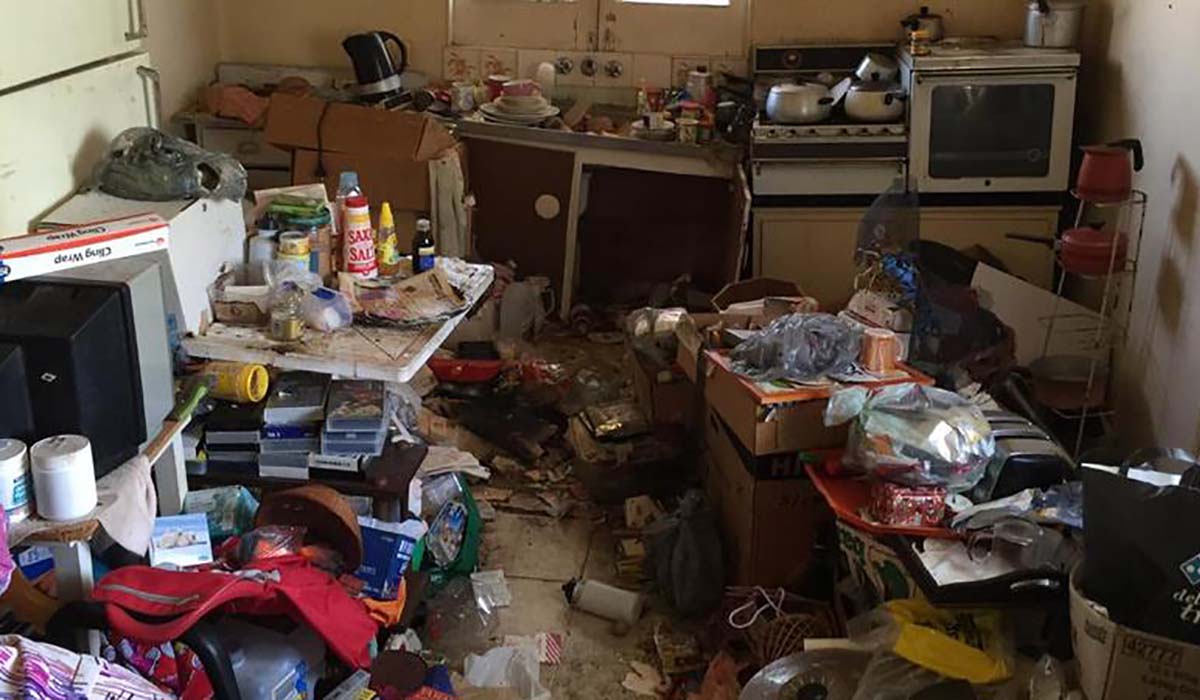How to Cope with Senior Squalor Syndrome
Do you have newspapers piled up in your house, in hope that you will get to read every single fascinating article? Do you collect ketchup and sugar packets on your road trips and save them? Have you purchased “bargain deal” items that you have no use of? Do you use your stall shower as a storage unit?
Are you a potential hoarder? Don’t be so quick to judge yourself. Unlike thousands of seniors suffering from, Diogenes syndrome, chances are that you would probably be happy if someone would come to your home and dispose of these useless items. Or would you? What is your self-diagnosis? Are you an accumulator or a hoarder?
Syndromes need an effective name to be taken seriously. According to Greek legend, Diogenes was a beggar who lived in a barrel in ancient Athens. He was the owner of only two possessions, his drinking cup and the barrel he lived in. He would become aggressive with anyone, including Alexander the Great, if asked to move away from his barrel. Diogenes never bathed, nor did he acknowledge anyone or anything outside of his immediate surroundings. He was not a hoarder by today’s definition, nor do senior squalor’s or hoarders of today have much in common with him, yet the name has stuck. My wife and I had the privilege several weeks ago of visiting a lonely senior, single, individual who is very learned and bright. She had no hesitation of inviting us into her home or should I call it, “her house of squalor”. Besides the unmade bed in middle of the living room, there were live roaches crawling on the stove. Clothes were hanging from different pieces of furniture. There was no order in this home. It’s a two-story home, yet, she only utilizes the main floor. This is probably due to a difficulty this elderly person has with climbing the stairs to her bedroom, so she uses her main floor exclusively. She apparently has no living relatives and still enjoys her so-called independence. A characteristic of some hoarders is the lack of embarrassment at the appearance of their home or room if he or she lives with other family members. Other hoarders are so ashamed that they will not allow anyone into their living quarters. In either scenario these seniors are no longer capable of taking care of themselves.
My wife and I had the privilege several weeks ago of visiting a lonely senior, single, individual who is very learned and bright. She had no hesitation of inviting us into her home or should I call it, “her house of squalor”. Besides the unmade bed in middle of the living room, there were live roaches crawling on the stove. Clothes were hanging from different pieces of furniture. There was no order in this home. It’s a two-story home, yet, she only utilizes the main floor. This is probably due to a difficulty this elderly person has with climbing the stairs to her bedroom, so she uses her main floor exclusively. She apparently has no living relatives and still enjoys her so-called independence. A characteristic of some hoarders is the lack of embarrassment at the appearance of their home or room if he or she lives with other family members. Other hoarders are so ashamed that they will not allow anyone into their living quarters. In either scenario these seniors are no longer capable of taking care of themselves.
Peek into the home of a “senior squalor”. You will see peeling wallpaper, rotten food and even dead pets. There are several reasons for senior hoarding. One is a physical degeneration of the frontal lobe of the brain which takes care of executive functioning. Executive functioning includes task management, long- term planning, motivation, as well as short-term planning. When communication between the frontal lobes and the rest of the brain weakens, it becomes too difficult for the senior to concentrate on certain normal tasks. The physical requirements of cleaning up become too arduous for the senior to tackle. This is due to their diminished mental capability to process and proceed with the cleanup.
Another cause of senior hoarding is social isolation for long periods of time and the lack of stimulation. Instead of calling this, “senior squalor syndrome” the name becomes, “senile squalor syndrome” as a symptom of the onset of dementia.
Some people tend to hoard; so, if you have answered the questions at the beginning of this article in the affirmative it’s time to get moving on early spring cleaning. There are professional junk removers, like, hoardingcleanup.com and 1800gotjunk.com. By the way, don’t worry about being labeled a hoarder. If you have a will to remove your unneeded possessions, you’re okay. It’s the true hoarders who need the serious help. The biggest single test for senior hoarding is to ask the hoarder to throw out an object that has absolutely no sentimental or practical value. The hoarder will refuse to discard useless objects such as rotting food or broken dishes. The hoarder will find a reason that he thinks is rational to hang on to the object. To an objective observer, the reason is completely irrational, indicating that the senior is in major trouble and needs help immediately.
The most effective strategy for treating senior hoarding is to remove the senior from his home and place him in a supervised living facility. Senior moving is always difficult and he or she will no doubt protest to be separated from his or her belongings. Supervision is necessary because in most cases hoarding is always accompanied by the inability to take care of oneself.
Seniors belong in a place where they will be helped to maintain a safe and sanitary standard of living which is not possible while living on their own. Betty, an LHNA at an assisted living facility in Medina, OH recommends to present the quality of life benefits to your loved one. They will be the ultimate decisions makers on making the move or not. Professionals do not recommend moving senior squalor’s into their children’s homes because, unfortunately, the problem will not be solved. To live with a hoarder is very difficult, since, even if you would allow his objects to remain in his or her room, they will end up spilling out into common family areas. Even drawing boundaries will not work long term and will ultimately cause family disharmony.
It would be effective to insist that your senior visit his doctor to check up on the possibility of dementia or other psychological disorders. However, even if the doctor prescribes medications formulated from protocols for obsessive compulsive disorders, these interventions are unlikely to work. This is because you will not be sure of the senior will take the medication diligently and he would also require a therapist to successfully implement major lifestyle changes. Care givers can research ideas such as reminiscence therapy which help deal with dementia.
If your parent must stay in his or her home, you should enforce boundaries of what can be kept in their homes. Dangers of falling, fires and potentially sickening bacteria are hazards that must be seriously addressed in these seniors’ homes. Fires are very often caused by hoarders. Fire needs fuel and the hoarder’s possessions become that dangerous fuel, especially newspapers and magazines. Here is a true story of a fire in a city in Maryland. The fire began in the hoarder’s house which resulted in the destruction of the next-door neighbor’s house. A small two-alarm blaze in an attached row house grew to a fire that lasted more than nine hours because of the hoarder’s excessive collection of magazines, newspapers, and gas cans. The firefighters were forced to break down the wall of the first neighbor’s house since they could not get into the hoarder’s house where the fire originated due to all the debris of the hoarder.
Jessica Sholl has written a book describing the details of her mother’s hoarding. It is titled, “Dirty Secret: A Daughter Comes Clean About Her Mother’s Compulsive Hoarding”. Sholl describes the details from her childhood when the hoarding began and as it gets progressively worse with her mother’s aging. Ultimately, when her mother becomes sick and hospitalized, Scholl confronts the problem. Coming into the hallway of her mother’s house, Scholl faces a vestibule filled with boots, coats, marshmallows, dozens of plastic garbage bags filled with unused purchases. To Sholl’s horror, at the bottom of the piles of newspapers and unopened letters, she discovers a large, lightweight mysterious box: her mother’s husband, Roger’s ashes.
Getting back to our original questions at the start of this article. Are you an accumulator or a hoarder? If these stories disgust you and you would like nothing more than to make a clean sweep of your unneeded objects, then you are just plain sloppy.
Steps to ridding the home of useless items
1) Start small and break down the job into clearing small areas or rooms over periods of time- not at once. Throwing away even one or two items at a time is a victory.
2) It may sound mean, but the only solution is to strictly and routinely purge items that are no longer useful. Dismiss from your psyche, unhelpful phrases like “but it was a gift,” “but it might fit someday” or “I might need it in a few years.” These phrases make your clutter control you, instead of the other way around. Donate unneeded items to your local thrift or charity store.
3) Beware that whatever you do, don’t let a purged item travel back into your home or work space.
4) After your first big purge, institute a monthly or quarterly purge to get rid of any junk that has accumulated. There’s a middle ground between saving every keepsake and trashing all your childhood treasures.
5) Find a box. It can be of any size, shape, color or pattern you desire. That will be your keepsake box. Anything that fits in that box can stay. Once it gets full, it’s time to go through it again and decide what you really, really can’t do without. You can scan pics or documents onto your computer for posterity. With your computer and your keepsake box, you get to both see and feel your precious memorabilia.
Besides for the primary gain of having a house clean from clutter there is a physiological benefit. Having an orderly house is a reflection on the members living inside it. Clean bathrooms and bedrooms give an overall sense that one’s house is free from germs. That includes clothing, bedding, and bath cloths. It also helps us have positive attitude on tackling the challenges of life. If you don’t have the time hire someone once or twice a week. You will see that it can make a world of a difference.
